|
September 1960 Electronics World
 Table of Contents
Table of Contents
Wax nostalgic about and learn from the history of early electronics. See articles
from
Electronics World, published May 1959
- December 1971. All copyrights hereby acknowledged.
|
Here is a snapshot of how
a career in electronics looked in the year 1960, per an article in Electronics
World magazine. The field of electronics was in transition from vacuum tube
technology to semiconductors, from point-to-point wiring in chassis to printed
circuit boards, and from analog to digital. Opportunities abounded from all
angles - legacy, contemporary, and futuristic. Jobs in electronics were readily
available for people of education levels ranging from high school to
post-graduate. Annual pay began at around $2,600 for assembly line workers to
over $5,000 for experienced technicians. Assistant engineers and communications
specialists with some college began at around$3,000 and ranged up to $8,000 or
more for test engineers. Degreed engineers could expect to start at around
$5,500 and go up well past $23,000. For a reference point, $1,000 per year in
1960 is the equivalent to about
$9,317 in 2021 (about a 10x increase), per the BLS. That puts equivalent pay
ranges from $24k/year to $214k/year. That is not real far off from current
levels. I don't know how fringe benefit levels factor into total compensation
numbers.
While we're on the subject of jobs, take a look at the list of
engineering and technician openings posted here
on RF Cafe.
Making Your Career in Electronics
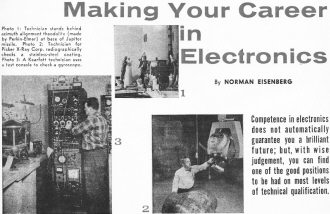
Photo 1: Technician stands behind azimuth alignment theodolite
(made by Perkin-Elmer) at base of Jupiter missile. Photo 2: Technician for
Picker X-Ray Corp. radiographically checks a stainless-steel coating. Photo 3:
A Kearfott technician uses a test console to check a gyroscope.
By Norman Eisenberg
Competence in electronics does not automatically guarantee you a brilliant future;
but, with wise judgment, you can find one of the good positions to be had on most
levels of technical qualification.
Thomas Edison, trying to improve his incandescent lamp in 1883, noted that electrical
energy seemed capable of crossing a gap between two conductors - a hot filament
and a positively charged plate - in a vacuum. Why this "Edison effect" occurred
or how it could be used was not understood. Some 13 years later, Sir J. J. Thomson
provided clues, involving the flow of electrons, in his investigations and conclusions
concerning the electron theory. Then, in 1907, Lee de Forest found a way of controlling
this electron flow in a vacuum tube by introducing a grid.
The last event triggered a series of developments which, as history views such
things, rapidly projected the world into a new era, the age of electronics. From
Edison's modest observation, electronics has become, in little more than two generations,
a complex and pervasive area of science and technology, comprising many fields,
"sub-fields," and combined fields that cut across, up, and down through virtually
all fields of endeavor in all parts of the world. It has furnished us with products
our grandparents could only have dreamed about (or could not even have dreamed about)
from miniature hearing aids to space ships. It has involved large numbers of people
in many ways.
There was a time - within the memory of most of us - when the "man in electronics"
was a fellow down the street who fixed radios. Today a "man in electronics" may
be testing critical metals, or using a 200,000-power microscope, or measuring miniscule
voltages from a living brain, or listening to signals from outer space, or designing
an industrial control system - or still doing well at repairing home radios plus
a host of other appliances including TV sets, auto radios, hi-fi equipment, and
Citizens Band gear. Still growing, this gigantic industry has already become the
fifth largest in the U.S.A., with an estimated annual revenue approaching $15-billion
and employing more than 1,700,000 men and women.
Are There Openings?
Impressive as the size of this "task force" is, we are often told it is inadequate
for present assignments and anticipated expansion - not always in terms of available
numbers but (perhaps more important) in terms of specific skills and training. Thus,
while electronics undeniably offers a vast job market, it often is a selective market,
particularly with respect to advancement and the better paying jobs. For the same
reason, of course, it is somewhat competitive - although, at the top job levels,
the jobs themselves often compete for the man.
In any case, electronics is one of the best career-potential fields today. According
to a recent study made by David L. Golan, a leading employment consultant and head
of Stevens Associates, N.Y.C., its horizons are constantly changing to present new
vistas. One of the results, for example, of a recent Supreme Court decision involving
patents and design development was to place a number of designs into public domain.
As a result, companies with sufficient capital could move ahead into diverse areas
that were not before practical, opening new opportunities. Since mid-1959, for example,
RCA has made a commitment of some $800-million to be invested in the next five years
in computers. Others, such as Philco, Burroughs, National Cash Register have also
entered this area or are about to do so. According to Golan, this is just one example
of how "the field suddenly explodes into new facets, with newly created job openings
for qualified personnel," even where the supply of trained people seemed adequate
a short time before.
Throughout the field and its many ramifications - of which computers, ultrasonics,
nucleonics, automation, and so on are only a few - there is, of course, difference
as to what constitutes "qualified personnel," how much they can earn, and how far
they can go. Different types of operations, different products and services, sometimes
different parts of the country all add up to create exceptional dips and peaks in
any "average" or "normal" line of development. Nonetheless, and keeping the possibility
of exceptions in mind, it is feasible to describe something of a pattern as regards
training, jobs, salary levels, and advancement. Details and specifics are listed
in the accompanying tables, based largely on the recent Golan-Stevens study and
other industry sources. As indicated, the entire field of electronics, from a job
standpoint, can be classified in terms of positions requiring relatively little
technical training; those that require technical training of a specific nature below
the college level; some with college training, although not necessarily a degree;
and those which definitely demand a college degree. Note that the indicated requirements
are for entering a specific job; advancement almost always involves additional training
and study.
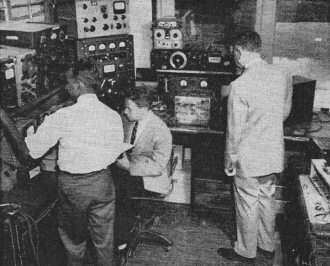
Engineers and technicians, in hearing-aid development for Sonotone
Research Laboratories, are making acoustic tests.
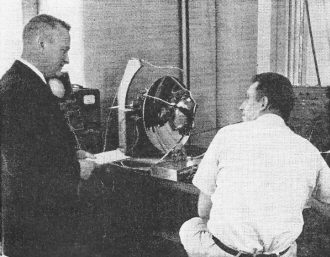
Neither chief of electronic design department (left) nor engineering
assistant (right) for M. Ten Bosch has a degree.
Bottom of the Ladder
To begin with, let's take the person with little or no specific technical training
or job experience, but with interest and proven or indicated aptitude - a budding
radio ham, for example, or a man who has tinkered with small electronic construction
projects at home. At the very least, such a person could start as a trainee or "junior
electronic technician." An example of the kind of job he could get might be, perhaps,
simple wiring and testing under supervision, at a salary of $55 to $70 a week. Actually,
such a job would constitute an apprenticeship.
Under conditions of normal industrial growth, that man could expect to earn between
$85 and $100 a week after one or one-and-a-half years. With suitable training (either
at an outside school or through in-plant training), he could rise steadily. It is
not uncommon to find, after a three-year period, that such a man is designated as
"senior electronic technician" at pay up to $130 a week, or as "junior foreman"
at $100 to $105 a week, or even "senior foreman" at $125 to $150 a week. Work such
as testing or mock-up wiring, at a higher-than-beginner level, would require that
a man have the ability to visualize things spatially. Higher positions in this area
would require some knowledge of mathematics as well. On the other hand, another
major area of work primarily involves manual dexterity. This would be in parts and
components assembly. Interestingly enough, many of the jobs requiring so-called
manual skills are being filled - and quite well, too - by women, although in supervisory
posts it is generally the men who take over.
Promotion in this area may lead to line foreman, or assistant foreman, or into
quality control. With solid mathematical training, plus specialized courses and
proven administrative ability, one could eventually work into statistical quality
control, a fairly high-paying type of work. At the quality-control level, you generally
move out of the "hourly rate" class into the "yearly salary" range, specifically
$6000 to $8000. Statistical quality control pays up to $10,000-$11,000 a year.
Sales and Service
Yet another major area for the untrained, but talented, beginner would be in
sales and service. A newcomer might start as an apprentice at the bench, under supervision,
earning $50 to $65 a week. After two years, if all went well, he should have learned
enough to warrant a salary of $90 to $100 a week. In time, he could be earning about
$125 a week; as a field service technician he might get $150 weekly.
An entry into sales work could be made, perhaps, after two years with the company.
Naturally, the company's needs and the man's own abilities would have to agree for
this to happen. The sales field, generally, is tricky and difficult to generalize
about. Admittedly, in sales, you will find some of the highest paying positions
in any industry. Industrial sales generally offer higher average earnings than consumer-product
sales, although individuals in consumer-goods sales do, at times, earn more than
industrial sales personnel.
In any case, sales work, despite its well-known returns, can be unstable. Take,
for example, the steady decline in the sales of specific types of home entertainment
equipment - notably AM radios - which, according to EIA figures, went downward after
1948. Also consider the slow fall in TV set sales after 1956. Often as not, such
declines are not so much a matter of "bad times" as a result of periodic fluctuations
or intra-industry undercurrents that are tricky to assess. On the other hand, they
can be compensated for. For example, when AM sales went down, FM sales began to
go up. Hi-fi components cut into package sets, and so on. Somewhat less obvious
would be periodic changes in car radio sales. Here, the number of sets sold relates
directly to the number of new cars sold; and the latter number follows an apparent
three-to-four year cycle. Thus, a man who did very well in 1955 selling car radios
might find his earnings down in 1956 and 1957, but picking up again in 1958. The
sales work field takes, among other qualifications, a "head" for this sort of anticipatory
reckoning as well as the ability and wherewithal to "ride it out" at times.
Technical Training
For the technically trained, non-college, non-sales-minded person there are other
well paying areas. The specific form of training could be that obtained through
a technical school, either residence, or correspondence, or a combination of both;
a military-service technical school; a company-sponsored school such as those conducted
by RCA, IBM, AMF, and others; or through in-plant or on-the-job training. And it
could be obtained before or during actual employment.
The most typical electronic schooling would give a man a solid grounding in basic
electronic theory and circuits, plus laboratory or workbench practice. He would
become familiar with test equipment as well as some of the maintenance and operation
of practical equipment. The more math he can absorb during this training, the better
off he is likely to be in the long run. While math may not be essential to filling
a good many jobs successfully at the outset, it may be a requisite for advancement
later on. It would be a "must" in certain fields such as design work or advanced
jobs involving computers.
A broad academic base in electronics often saves a man years of job apprenticeship.
It also permits him to start at a higher level than he could without schooling.
A spokesman for Reeves Instrument Corp. has said that a man with only six months
of real electronic schooling is likely to be more valuable to the company than a
man with 18 months of job experience and no equivalent schooling.
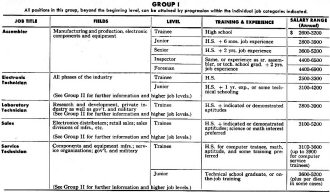
Group I - All positions in this group, beyond the beginning level,
can be attained by progression within the individual job categories indicated.
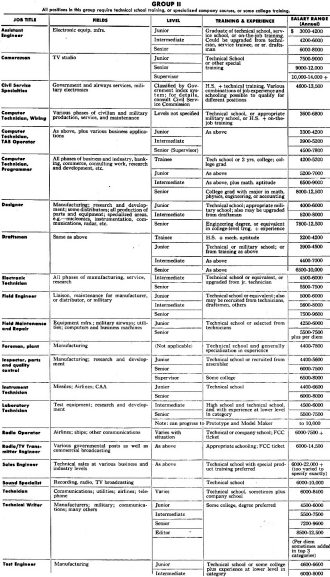
Group II - All positions in this group require technical school
training, or specialized company courses, or some college training.
All positions in Groups I and II, appearing above and on the
preceding page, are open to personnel without college degrees.
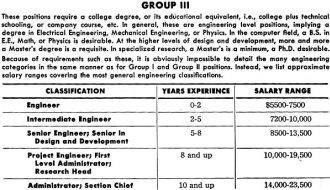
Unlike the positions in the preceding groups, these require college
degrees.
Not only can the trained man start at a higher level (what might be for the untrained
man an intermediate level), but he can move up faster and higher, and into more
interesting and diverse fields. Research and development, industrial controls, broadcast
engineering, and instrumentation are only a few. A beginning laboratory 50 technician,
for example, in instrumentation, might start at $65 to $85 a week. After a three-
to five-year period, he'd be earning up to $125 a week. If, in the course of his
work, he became a specialist at, say, wiring prototype models, he'd earn $8500 a
year. Once in this area, he could take advanced study and eventually find his way
into design work, with a salary in the five-figure bracket.
An "intermediate technician" could also use his background and experience to
qualify for such fields as airways communications, government monitoring, or general
broadcasting.
The man "moving up" is invariably a man "brushing up." Sometimes when a company
finds "its man," it will sponsor his schooling at a reputable institute, which may
or may not lead to a degree, depending on the courses chosen and the needs of the
particular study program. Recently, for example, a relatively small company in Brooklyn,
N. Y., which specializes in microwave research and development, was looking for
a senior electronic technician. The salary offered was $125 to $130 a week, plus
fringe benefits. Among the latter were a medical plan and other conventional advantages
- plus sponsorship through a college degree in engineering or physics, all expenses
paid.
Military Training
What about military service schools? These provide training similar to that obtained
at other schools. They can, and often do, prepare a man for comparable opportunities
in private industry. Some industrial firms, however, may deprecate the value of
military technical training to the extent that the applicant's performance level
cannot be readily ascertained, due to the inaccessibility of the man's detailed
performance record while in service. Nonetheless, completed military technical training,
plus in-service performance in the man's indicated specialty, does provide higher-level
entry into private industry than any school training with no job experience.
A radio transmitter operator, for example, will have experience considered "directly
transferable" for, say, broadcast studio work. Even more "directly transferable"
would be men in such specializations as Ground-Control Approach or Instrument-Landing
systems. Here, competent men would qualify readily for field service work with equipment
manufacturers, or as operators of the equipment directly at airfields.
Advanced Training
A number of well-paying careers may be developed by those who do not have a degree,
but do have some (two years or more) college training in a specialized interest
group, such as math, physics, design, or engineering. This kind of training, combined
with some experience in any specific phase of electronics, could qualify a man for
any of several jobs that start at the $6000- to $8000-a-year level. Much would depend,
of course, on personal interests and abilities, as well as available openings. Such
areas would include: field service engineering; sales engineering; sales promotion
(including advertising and public relations); technical writing; product engineering;
design engineering; special work with computers; and many more. These jobs cover
the range from intermediate to near-top levels throughout the industry.
Men without degrees, who prove themselves, can go high - although there may be
specific situations barred to them. One such might be a spot that involved direct
supervision of a group of men who had degrees. Another would be a position where
one of the requisites actually called for a specific type of degree or an advanced
(Master's or Doctor's) degree. Outside such instances, experience can often represent
the equivalent of a degree in terms of a man's qualifications. From a salary standpoint,
two years of experience are roughly the equivalent of one year's education.
As for the college degree itself, it is often, at present, a passkey to a very
wide diversification in job opportunities. A man fresh out of college may, indeed,
be able to start at $6000 to $7500 a year. With a Master's degree, and still no
experience, he may even start at $9000. A doctorate, without job experience, can
command $10,000 to $11,000. The "normal top" for a man with a bachelor's degree,
after some years of experience, is estimated between $13,000 and $15,000.
At these levels there actually are more job categories than at the lower levels
- but each one is more highly specialized. This perhaps requires some explanation.
To most people who are not engineers or involved professionally in the electronics
field, there seems to be little difference among engineers. "An engineer is an engineer."
The most basic differences recognized at all might be among production, design,
and research engineers. While this simple view may have been true ten or more years
ago, it has lost its validity since then.
Today, job requirements at the higher levels have become so specialized that
even the highly competent graduate engineer cannot readily step from one specific
type of work into another. Additional training is required; this re-orientation,
or preparation for new specialization, may take from three months to two years,
depending on the man himself and the job he is to fill.
Group III
These positions require a college degree, or its educational equivalent, i.e.,
college plus technical schooling, or company course, etc. In general, these are
engineering level positions, implying a degree in Electrical Engineering, Mechanical
Engineering, or Physics. In the computer field, a B.S. in E.E., Math, or Physics
is desirable. At the higher levels of design and development, more and more a Master's
degree is a requisite. In specialized research, a Master's is a minimum, a Ph.D.
desirable. Because of requirements such as these, it is obviously impossible to
detail the many engineering categories in the same manner as for Group I and Group
II positions. Instead, we list approximate salary ranges covering the most general
engineering classifications.
IMAGE HERE
As an example, it is no longer enough for a company to look for a "communications
engineer." Now the category, must be narrowed to, say, a "microwave specialist."
Or, again, take the specialty known as "analogue-computer circuitry designer." Digital
computer circuitry designers need not apply! And so it goes, into ever-narrowing
and more specific types of work. Recruitment consultants and personnel men alike
find it difficult to screen applicants for such specializations, which require a
kind of pin-pointing referral demanded by many of today's electronic firms. This
intra-industry problem, as well as the question of sheer numbers required versus
those available, contributes to what has been called our "manpower shortage," although
the term is often misunderstood. This shortage, actually defined by the need for
extreme specialization, puts college graduates - as well as others with less training
presently employed or planning to enter the field - in the position of being faced
with many choices, of job type, of company, of locality in which to work and live.
Evaluating Job Situations
To these people, a host of factors must be weighed in arriving at a decision.
Among them would be the stability of a particular company, its policies regarding
personnel development, fringe benefits, educational extension opportunities, and
so on. Also to be considered, if information is available, are such factors as the
nature of the company's growth. A favorable sign would be continued increases in
expenditures for both sales and research, as indicated in stockholders' reports.
A relatively small annual turn-over in personnel is another favorable sign. The
seasonal or non-seasonal nature of its products might also be important.
Finally, there is the matter of the living conditions in the area related to
where you'll be employed. Travel distance to and from work might be considered,
as well as the residential aspects of the area in terms of cultural, social, religious,
and educational factors that may be important to you or your family. In other words,
"case the area" -using your own good sense (and senses) to evaluate it in terms
of your interests and needs. For specific information, consult the local Chamber
of Commerce, talk with real estate agents or other local people. One revealing indication
of the "liveability index" of an area would be the published lists of teachers'
salaries, generally available from the Board of Education or the Town Clerk.
In sum, for maximum job satisfaction you should do a little "market research"
of your own. Less than a generation ago, such an attitude was well-nigh unheard
of. But then, so were transistor radios, electronic thinking machines, and a lot
of other things that today we take for granted in this growing field.
Posted August 16, 2021
|















